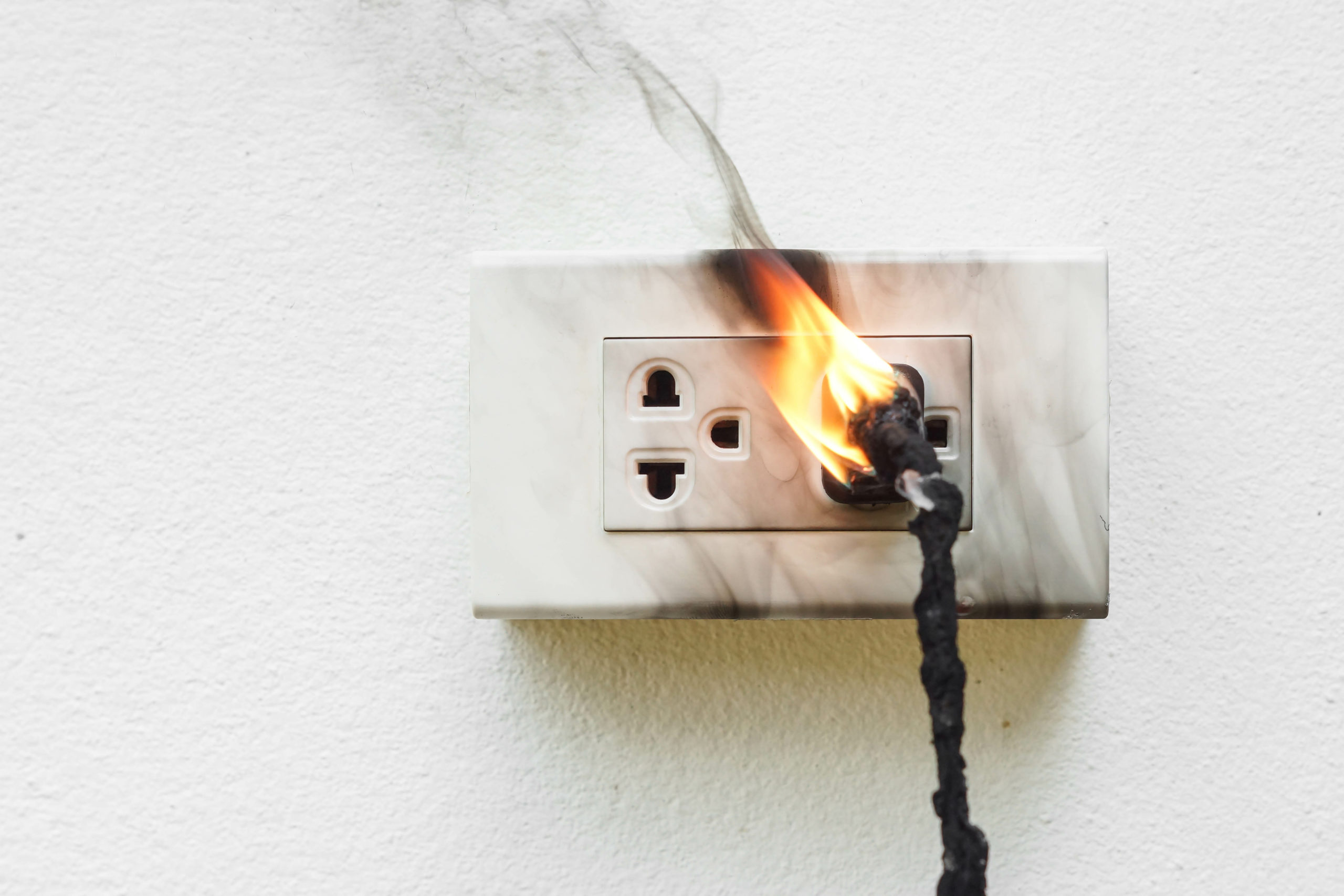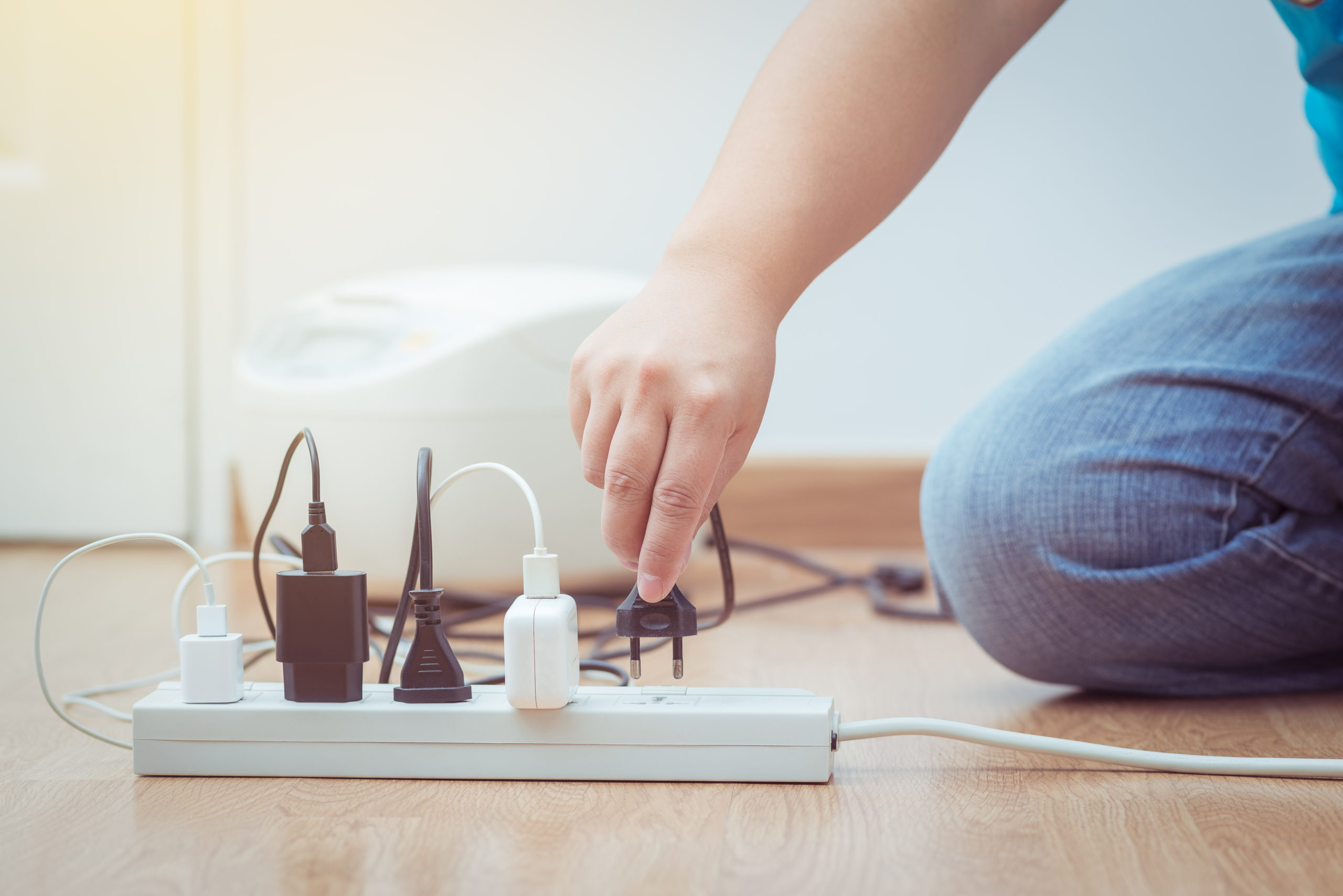Electrical Dangers and Warning Signs
Contents
Electrical Dangers and Warning Signs
As we rely more and more on electricity, the potential for electrical safety hazards rises. While electricity use carries unavoidable risks, being aware of what these risks are and how to identify issues will help you lower the risk of electrical accidents in your home or business.

01. Short Circuit
Short circuits occur when an electrical wire carrying current touches another wire or when insulation is worn down or damaged and the live wire is exposed. When electricity completes the circuit in a path shorter than the path intended and follows a route of less resistance, a short occurs. To complete a circuit, a hot and neutral wire must be present. Common reasons for short circuits include loose connections, aged and outdated wiring, faulty appliance wiring, and damaged insulation.
Typically, the first sign of a short circuit is a flipped breaker, but in some cases, short circuits will show in other areas. Appliances malfunctioning, warm spots near outlets, and popping or crackling can all be dangerous signs of a short circuit. Have the affected circuits inspected by a professional before further use.
Malfunctioning Appliances
Often, inconsistent power issues only show themselves through the performance of appliances. Many appliances are wired to run on a specific voltage, and fluctuations in that voltage can have many peculiar symptoms. You may have a short circuit if your appliances are running inconsistently, emitting excessive heat, or if the breaker for that area is continuously tripped. Shorts can also occur within appliance wiring. If you find that your appliance cords are damaged or the insulation as melted, the short may be within your appliance. Unfortunately, shorts in your outlet or in appliances can quickly damage expensive appliances, so be sure to have them checked out promptly.
Warm Spots Near Outlets
Warm spots near outlets are sure signs of a short circuit or ground fault. While they may be caused by only a slight leakage of electricity and may seem harmless, they can escalate quickly and, in some cases, cause damage or fires. Circuits with leaking electricity should immediately be closed until repairs can be made.
Popping or Crackling
Popping or crackling in outlets or light fixtures can be typical in many older homes. This is usually caused by insufficient connections in outlets, switches, or light fixtures. While it’s possible for wiring to operate in this condition for many years without an issue, these symptoms should not be ignored. These conditions can quickly lead to ground faults and possible danger.
In a modern home, the arc fault circuit interrupters (AFCIs) in the breaker box are designed to stop short circuits. The breaker senses the surge of current and flips to prevent the current from causing damage or starting a fire. In rare cases where the breakers don’t perform correctly, there is the potential for damage or fire.
If your home was built during or before the 1960s, then it may still use fuses to interrupt short circuits. Fuses function similarly to breakers, but they must be replaced after any fault occurs. Fuses can become unreliable as they age, so if your home has a fuse box, consider replacing it.
02. Ground Fault
A short circuit means that a circuit has been completed without running its full intended path, causing electricity to leak through to the neutral wire. With ground faults, the circuit is also shortened, but rather than touching the neutral wire, the hot wire makes contact with the grounding wire or grounded portion of the system, such as a metal electrical box.
The first and most common sign of a ground fault is a surge of electricity that trips a properly functioning breaker. In addition, if you’re noticing strobing lines on your tv or computer, buzzing sounds from electronics, or unexpected shocks from metal appliances, these may be signs of a problem.
Ground faults are commonly caused by worn wire insulation or miswiring. However, they can also result from water infiltration into electrical boxes or improper insulation of power tools or appliances. While a properly functioning breaker will prevent a continuous ground fault, it is often not fast enough to prevent some electricity from escaping. This is not usually an issue unless this current is passing through your body, in which case this short burst of electricity can be a shocking experience.
This is why most bathrooms and kitchens (areas that are most susceptible to ground fault through a human body) are equipped with ground fault circuit interrupters (GFCI). GFCI outlets are most readily identified by their square body and test and reset buttons. GFCI outlets are designed in the case of a ground fault to shut off a circuit’s current before it can damage your fingers, hands, or heart.
03. Outlets

Outlets That Don’t Work
If outlets fail to work properly or don’t work at all, this can be a sign of many different issues such as flipped or faulty breakers, a faulty outlet, overloaded circuits, aged or damaged wiring, or improper wire attachments to the back of the outlet. In any of these situations, it’s important to flip the breaker to the off position and check the outlet with a wire tester to ensure that there is no electrical current before performing any work. Never ignore a faulty outlet, which can prove dangerous if left unrepaired.
A common reason that outlets fail to function is simply a tripped breaker. Check the breaker panel to see if this is the case. If the breaker continues to trip after you’ve reset it, the outlet may be overloaded or faulty. In most cases, a tripped circuit breaker is caused by a temporary overload on the circuit or a short circuit in a device that’s plugged into it. In rare cases, however, a loose wire in an electrical box could be the source of the problem.
Your home may be wired in a way that causes multiple outlets to shut off at the same time, even when the circuit breaker isn’t the cause. Check whether other outlets are dead. If all the outlets in the room or along an entire wall aren’t working, the problem will probably require an electrician. If you see sparks, charring, or smoke, take the problem seriously. Stop using the outlet immediately and contact an electrician.
Overloading Sockets
A socket can be overloaded by too much voltage passing through it. Any single appliance or electrical device is not likely to do this. When you imagine an overloaded socket, you probably imagine dozens of wires stacked into one socket like in the popular Christmas Vacation scene. While this presents an obvious problem, overloaded sockets can look much more mundane. Anyone who’s lived in an older home has seen the need for stacking outlet splitters. As few as three or four high-voltage appliances can easily overload a single socket.
To prevent this, use only single power strips to power multiple devices from a single outlet instead of stacking splitters. Outlets that have multiple accessories plugged into them should be checked at full power for heat, charring, and proper appliance performance. Issues in any of these areas could be symptoms of an overloaded outlet. You can prevent overloading sockets by knowing how much power is required to run the items you plug into them.
Hot Outlets
An electrical outlet should never be hot. Certain devices and even prolonged use of an outlet can cause it to be warm, but never hot. If it is, you should take it as a sign of a larger problem and call an electrician to address it immediately.
The causes of a hot outlet could be an overloaded circuit or damaged or old wiring. The first thing you should do is to turn the circuit breaker off for that outlet and unplug everything from it. Call an electrician as soon as possible if the outlet is truly hot. If you think that the outlet may just be warm from a certain device, wait to see if it will cool down, and if it doesn’t, then call an electrician. If the outlet is too hot to touch, you could be at high risk for a fire.
Ungrounded Outlets
Ungrounded outlets essentially have no protection against possible arcing and fire hazard. Electricity is always seeking to find its way back to the ground, which is why it’s important for outlets to be grounded. If you have a short circuit, a grounding wire provides a safe path for electricity to travel to the ground, while an ungrounded circuit could cause electrical shock.
Typically, three-prong outlets are grounded. However, the only way you can be sure the ground is functioning properly is by testing it. If your home was built before the 1960s, you may have two-prong outlets that are not grounded. In this case, it’s best to have an electrician rewire your home with modern grounded outlets. While this can be costly, the safety of your family and your home are worth the expense.
Cracked or Broken Outlet Plate
Cracked and broken outlet plates are common, especially in older homes. A cracked outlet plate will eventually fall off, which can expose the wires and present the risk of both shock and fire. The plates are important because they cover all the things, such as electrical terminal screws, that can give you a powerful shock. In addition, the plates stabilize the outlet. When a plate is damaged or missing, the outlet wears down faster and the wires may be loosened. Plates should be replaced as soon as possible to prevent damage or harm.
Inconsistent Power
If your outlet has inconsistent power, which can cause problems like flickering lights, the outlets may be old and unable to keep up with modern demand. If this is the case, have your outlets inspected by an electrician. Old outlets can lead to hazards such as fire, short circuits, and shock.

04. Time to Rewire Your Home
If you’re worried about your home’s electrical wiring and questioning if it’s time to rewire, there are warning signs that can help you decide. If you notice flickering lights, frequent blown fuses or tripped breakers, a burning smell, or a buzzing sound, you should have an electrician inspect your system to determine if you should rewire.
Old Wiring System
You want to make sure your wiring system is up to date. If your electrical system has not been replaced in 30–40 years, it’s a good idea to look into replacing it now. An old wiring system can easily lead to electrical fires if not properly managed. You can tell you have an old wiring system by looking for the following:
- Damaged or missing wire insulation—This is a common issue that should be addressed by a professional.
- Wiring that is surrounded by building insulation—This issue occurs most commonly with knob-and-tube wiring.
- Fuses with more than 15 or 20 amps—Old wiring is often over-fused at 30 or 40 amps, which can be a problem.
- Fuses that blow regularly—This indicates an inadequate power supply.
- Exposed splices—Splices should be soldered.
Knob-and-Tube Wiring
The oldest type of wiring found in homes is called knob-and-tube wiring. This type of wiring can be identified by poorly protected or unprotected wires that run through white ceramic tubes to white ceramic knobs that are nailed into floorboards or ceiling joists. This wiring remains in homes throughout the country, but it poses an increased risk of faulty electrical circuits and potential fires, so it should be removed and replaced as soon as possible.
While knob-and-tube wiring is not inherently dangerous, it does present some issues. It does not have ground wires, raising the risk of electrical fire and shock. In addition, the wire insulation is rubber, which breaks down over time, as opposed to modern plastic. Given the age of knob-and-tube wiring, it’s often difficult for electricians to identify hot and neutral wires.
Aluminum Wiring
If your home was built in the 60s or 70s, you may have aluminum wiring. Aluminum corrodes and can quickly wear out and overheat, which can lead to electrical fires. Copper wiring, which resists corrosion better than aluminum, is the safer modern option. Aluminum wiring is also prone to loosening over time, which creates gaps between the wiring and connectors, elevating the risk for overheating and fires.
Old wiring is not only a safety hazard, but it can also make your home difficult to insure. If your home has knob-and-tube wiring, for example, it may be hard to find an insurance company that will cover it, and the company will probably charge higher rates due to the increased fire hazard.
Cost to Rewire
The national average cost to rewire a home is around $2,100, but the cost can vary greatly depending on several factors. Not all homes are wired the same, and some layouts can make rewiring especially difficult. The greatest challenge in rewiring a home is accessing the places that each circuit needs to reach. In a new construction home, wire is pulled through open stud walls and wired with ease. In an existing home that already has insulation, drywall, and paint, this becomes much more of a feat.
Calculating the actual cost can be very difficult due to the large number of variables at play, including the age and size of your home, the number of rooms, and the type of existing wiring. Not all rooms will cost the same to rewire. A bathroom or kitchen, for example, will be much more expensive than other rooms in your home. To ensure you’re getting the best value, get estimates from several electricians before hiring one. The cheapest option may not be the best option, but multiple estimates can help you determine the right fit.
Improved Home Resale Value
If you are planning to sell your home, it may be a good time to rewire. While it’s an investment, it can help ensure you’re able to get the full market value for your home. A potential buyer may not want to risk buying a home with old wiring. However, a home with new wiring can result in a much higher sale price.
05. Time to Call a Professional
Electrical issues should never be ignored, and many issues require professional service. If you are experiencing any electrical issues, don’t hesitate to call an electrician to perform an inspection. You should schedule an inspection if
- You’re planning to purchase a new home or sell your home
- Your electrical wiring is over 40 years old
- You’ve gone more than 10 years without an inspection
- You have warning signs of a problem, such as tripped breakers, flickering lights, outlets not working, or frequent electrical issues
- You’re renovating your home
Find an electrician you can trust. After the inspection, you can expect to receive a written report that includes recommendations for repairs and updates. If your system is old and hasn’t been inspected recently, you can expect to need to make some updates.
Emergencies
06. Common Emergencies
Electrical issues occur frequently, but if they’re not dealt with properly, they can quickly become emergencies. It’s important to be aware of common electrical emergencies and how to respond to them.

Power Outages
Power outages are the most common type of electrical emergency. They usually occur due to fallen power lines, energy shortages, or storms. If the outage seems to be isolated to your home, shut off all the power at the circuit panel, and unplug all of your appliances to prevent damage to your wiring and appliances. When the power returns, turn the breakers back on, and then wait a few minutes before turning your appliances on.
Electrical Fire
Electrical fires are among the most serious electrical emergencies a home can experience. They are often caused by overloaded, faulty, or exposed wiring. Make a plan to evacuate your home immediately in case of a fire. If you see sparks or your outlets are hot, turn off the power in your home at the circuit panel. If you can react quickly enough, turning off the power could stop a spark before it becomes a fire.
Fallen Power Lines or Storm Damage
Storms can wreak havoc on power lines. If you see a downed power line, be sure to stay at least 40 feet away. The power line could still be live, even if it doesn’t seem like it. Avoid touching anything that is in contact with the line, and call authorities immediately.
Electrical Shocks
Electrical shocks are a fairly common occurrence that can vary in severity. If someone has experienced a severe electrical shock, do not touch them while they’re still in contact with the power source. Cut off the power supply if possible or move the appliance away from them with a non-conducting object, such as one made of wood or rubber, and call 911 immediately.

07. Being Prepared for an Electrical Emergency
It’s always best to be prepared to safely handle whatever events may come. While you can’t predict when an emergency might happen, you can take steps to prepare to keep your home as safe as possible when it does.
Understand Your Circuit Panel
In most electrical emergencies, your circuit panel should be one of your first stops. Your circuit panel is the mind behind your home’s electricity. Turning power off at the panel can make many emergency situations less severe, or even prevent a problem from turning into an emergency if done quickly. It’s important to be familiar with your circuit panel and know what you’ll need to do to turn off any part of your home’s electricity. It’s important to note that turning off the circuit panel should only be the first step if it doesn’t put you at risk. If there is a fire in your home, evacuating is the top priority.
Have a Fire Extinguisher Nearby
To be prepared in the event of a fire, your home should have a fire extinguisher. For electrical fires, a Class-C extinguisher is what should be used. These extinguishers are not water-based and are therefore safe to use with electricity.
Have an Escape Plan
Plans should be in place for any potential emergency. An escape plan is particularly important for electrical fires, as they can start and spread quickly. Just as you would for any fire, plot escape routes from every room in the house, and establish a common meeting area so that everyone can be accounted for.
Electrical Tips for Your Home
Following a few electrical best practices can help ensure that your home electrical use is as safe and efficient as possible.
08. Home Electrical Safety
Keep your home as safe as possible with the right maintenance practices and equipment.

Outlets
Outlets are an important part of home safety. Be sure that all outlets are secure and intact. GFCI outlets are important for preventing electrical fires in wet areas such as bathrooms and kitchens. They ensure a quick shut off if a problem occurs. Smart outlets and USB outlets are a modern addition that can add convenience, but they should be installed only in rooms that are considered dry areas.
Use Surge Protectors
Surge protectors protect your appliances and devices from harm during a power surge. Surge protectors send surges of electricity to a grounding component, which prevents damage to your device by limiting the amount of power that goes into it. Surges can be caused by lightning storms or even just too much power on your grid.
Use Correct Wattage in Light Fixtures
There are many options for light bulbs and fixtures today. It’s important to make sure that the wattage for your bulbs and fixtures match. All light fixtures have a maximum wattage. If you exceed that, you are at risk for electrical fires or damage to your wiring.
Only Use Quality Electrical Cords and Keep Them Tidy
If you’re using extension cords, be sure you’re using them for their intended purposes. Some cords are designed for outdoor use and others for indoor. As you accumulate cords, keep them tidy. This will not only make your spaces look tidier but will also prevent wear and tear on the cords. If your cords wear down, it could lead to exposed wires and shock.
Unplug Appliances When Repairing
If you need to make any repairs to electrical appliances, be sure to unplug them before attempting repairs. Electrical shock can occur easily during a repair. Just as you wouldn’t stick your fingers or tools in an outlet, don’t attempt to repair an active appliance.

09. Energy Efficiency
Energy efficiency can save you money as well as extend the lifespan of your electrical system. To improve your home’s energy efficiency, one effective solution is to upgrade appliances. Your water heater, refrigerator, washer and dryer, and light fixtures can all use excessive amounts of energy. Newer, more energy-efficient models could make a substantial difference in your utility bills.
Benefits of Lighting Retrofit
If you’ve already been researching energy efficiency measures for your home, lighting retrofit may be a familiar term. Lighting retrofit is the process of replacing components of your conventional light system with energy-efficient components. Sometimes, this involves replacing an entire system, but often, it is as simple as replacing the light bulbs with energy-efficient options. Lighting retrofit can have a number of benefits, including
- Improved light quality
- Fewer maintenance needs
- Smaller environmental impact
- Longer bulb lifespan
- Less use of air conditioning
- Reduced energy costs
Home Automation
Home automation is no longer out of reach of the majority of homeowners. Today, most things in your home can be controlled by an app. By connecting your devices, your home can become more efficient at running it’s normal functions like heating, cooling, and lighting. By having more precise control over your system, you can maintain the most energy-efficient settings throughout the day.
Your home automation system relies on wiring that connects it to your home’s main electrical system. Any type of short or faulty wiring can cause malfunction in the system. Electrical wiring can be complex, so be sure to hire a professional to install wiring and correct any problems. If you notice that your system is not operating correctly or if the automation isn’t working at all, it could be a problem with the wiring, and you should contact an electrician.
Powering Your Home with Renewable Energy Sources
To conserve energy and save money, unplugging your electronics, lighting retrofit, and home automation are great solutions. However, using renewable energy can do much more for your energy efficiency efforts. Renewable energy is power that is generated by natural sources. Sun, wind, and water are common sources. Renewable energy can save you money and increase your home’s value. It’s dependable and good for the environment.
Types of Renewable Energy for the Home
Planning for a renewable energy system involves looking at your current electricity use, researching codes and requirements, and understanding the options available to you. If you’re designing a new home, you can work with your contractor to incorporate renewable energy into your home’s design. Your local renewable energy company or state energy office should be able to tell you about requirements for renewable energy sources. Technology options include
- A small solar electric system is reliable and cost effective for office or home.
- A small wind electric system is the most cost-effective option for homes.
- A microhydropower system can power large homes.
- A small hybrid system can capture various sources of energy at their peak times, allowing you to power your home as efficiently as possible at all times.
Solar-powered systems convert the sun’s rays into electricity that can be used throughout the day. Solar panels generate power during daylight hours, regardless of whether it’s a sunny day (although sunny days provide more power). Wind-powered systems typically come in the form of wind turbines. The turbines are available in a smaller form for homes that can be free-standing or installed directly onto the building. If your home is close to a body of water, hydroelectric systems, such as microhydropower, could be a good fit for you. A hybrid system uses multiple sources of energy to provide constant power for larger areas.
Cost of Renewable Energy
The cost of a renewable energy system greatly depends on the size of the system that is needed, which is dictated by how much energy you need for your home. However, the cost of renewable energy solutions is going down every year, and the benefits often outweigh the costs. Small wind electric systems can lower electric bills by 50%–90%, which can make it a cost-effective long-term investment. Federal tax credits or local utility incentives can lower the initial cost of making the transition to solar systems.
Your electrical system is a critical component of your home, so it is essential to keep it working properly, safely, and efficiently. Because it can also be a source of danger, it’s important to be prepared for emergencies and address problems promptly to keep your home safe. If you’re considering upgrading your system, ask your contractor and electrician about enhanced safety features and energy-efficient options.